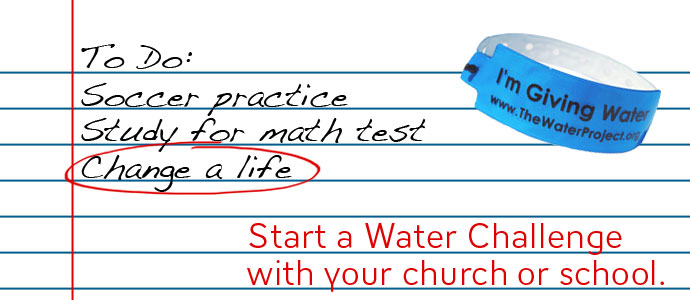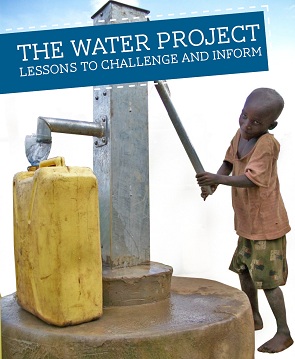Lesson Plan: Water Water Anywhere
Water scarcity is often a concept that students have difficulty truly visualizing. In this activity, students will go through three different stations for approximately 5 minutes each in order to experience the effects of water scarcity. The stations include:
- Water Abundance
- Physical Scarcity
- Economic Scarcity
Overview
In the first station, Water Abundance, students will see their water bottle (symbolic of their population) overflowing into a bowl with little effort and quite early on.
The second station, Physical Scarcity, will require students to prioritize which segment of their population (agriculture, industry, human) are most important to receive a portion of the limited resource, water. The exercise is set up so this station will never truly be satisfied as they will simply not have enough water to fill their whole bottle. The challenge will be to process what happens when part of their resources are not fulfilled (hunger, poverty, health, etc.)
The last station is Economic Scarcity. In this station, though students technically have enough water, they can not easily access it. Their "potential" clean water is sealed and prohibited while the resource that they are permitted to use is "far away" (on the other side of the room) and dirty. This symbolizes the resources, such as underground water, that the population does not have access to for economic reasons. Further, they must carry an extra weight with them as they walk, individually, across the room. The weight here is symbolic of the physical burden of collecting water, while the individual walk, is meant to remind students of the vulnerability and dangers of the process. This third station will likely simply run out of time before their water bottles are filled. This is symbolic of the fact that people in this situation often don't have enough time to both collect water and earn an income.
At the end of the 5-minute period, students will spend a few minutes in reflection, answering the questions on their Notes pages before rotating stations. At the end of the activity, a discussion of the concepts and challenges relating to water scarcity should be much more effective as students have experienced water scarcity in a more tangible way.
Materials
- Water, Water Anywhere Notes handouts (3 pages)
- 2 1-gallon jugs of water
- 3 large (27 oz) Water bottles (We have some great ones in our store!)
- 1 3-cup measuring cup
- 30 5 oz. disposable paper cups
- 3 large flat bottomed bowls for water bottles to sit in
- Small opaque pitcher (approx. 4-5 cups)
- Coffee Grinds or dirt
- 5 pound weight (This can really be any size. The intention of the weight is to remind students of the physical burden of carrying water. A real jerry can weighs more than 40 pounds when full. An alternative to a hand weight might be a backpack filled with heavy books.)
- Clock
- Marker (for labeling)
- Paper towels (just in case)
Procedure:
1. Label everything:
- Disposable paper cups per group: 7 "Agricultural Needs", 2 "Industrial needs" and 1 "Human needs"
- 1-gallon water jugs: 1 "Potential", 1 "Resources"
- Opaque pitcher and 3-cup measuring cup: "Resources"
- 27 oz. water bottles: "Population"
- Large bowls: "Water Abundant", "Physical Scarcity" and "Economic Scarcity"
2. Use the "Resources" gallon of water to fill opaque pitcher and 3-cup measuring cup.
3. Stir coffee grinds/dirt into the opaque pitcher to make it "dirty"
4. Set up each stations with the supplies (resources, needs and population) needed.
STATION 1: Water Abundance
- 1-gallon water jug labeled "Resources" (now partially empty)
- 10 paper cups, labeled "Agricultural/Industrial/Human Needs" as stated above
- 1 water bottle labeled "Population"; place inside "Water Abundant" bowl
STATION 2: Physical Water Scarcity
- 3-cup measuring cup labeled "Resources"
- 10 paper cups, labeled "Agricultural/Industrial/Human Needs" as stated above
- 1 water bottle labeled "Population"; place inside "Physical Scarcity" bowl
STATION 3: Economic Water Scarcity
- 1-gallon jug of water labeled "Potential" (still full and sealed, if possible)
- 10 paper cups, labeled "Agricultural/Industrial/Human Needs" as stated above
- 5 pound weight or alternative such as backpack with books
- 1 water bottle labeled "Population"; place inside "Economic Scarcity" bowl
- Opaque pitcher labeled "Resources"
- Clear path across the room to where the opaque pitcher is located (if you can't have students walk, just have students wait 30 seconds between pours)
5. As students come in, distribute Water Scarcity Handouts and explain that each station represents a part of the world with a different condition of water. The students will "travel around the world" stopping in each station for 5 minutes to read about the specific situation and then provide their citizens with water by filling their 27 oz. water bottle as instructed.
6. At the five minute mark, have students stop pouring and give them 2-3 minutes to write down their observations and reflections on the handout.
7. Have students CAREFULLY return the water from their "Population" bottles and station bowls to its "Resource." Be sure to have paper towels on hand.
8. Have students rotate twice to do all three stations.
9. Discuss the experience! Give students a chance to share their reflection responses. Be sure that students understand the symbolism of the various components, especially in economic scarcity.
Optional
You may want to have students write an essay for further reflection or use this activity to kick-off a Water Challenge(http://thewaterproject.org/thewaterchallenge.asp) or myWaterProject campaign (http://thewaterproject.org/start-a-fundraiser.php)
STATION 1: WATER ABUNDANCE
You are in an area of water abundance. Water conservation is something you know about, but never really seems relevant with your excessive access to freshwater and advanced technologies. Use what is left of your five minutes to provide water for this population. Fill the "Need" cups from your "Resources" and pour it into your "Population." Because of your abundance, all cups should be completely full as they are added to the bottle - make sure your "Population" bottle is inside the bowl to prevent a mess.
Observations:
Did your population have enough water to fill the water bottle? Explain.
Reflections:
What went through your mind as you kept pouring more and more water into the abundant population? Did you ever think it was too much? Reflect on the experience.
STATION 2: PHYSICAL WATER SCARCITY
You are in an area that has physical water scarcity. You may be located near a desert, or simply have had a population boom that has caused your old resources not to be enough. Use what is left of your five minutes to provide water for this population. Fill the "Need" cups from your "Resources" and pour it into your "Population." Because of your scarcity, water use is carefully allotted and conserved. Some cups will be half full while others are totally full. Choose carefully how you fill and mark your decisions in the chart below:
|
Cup: |
1 |
2 |
3 |
4 |
5 |
6 |
7 |
8 |
9 |
10 |
|
Need: |
Agric. |
Agric |
Agric |
Agric |
Agric |
Agric |
Agric |
Indus. |
Indus. |
Hum. |
|
None |
||||||||||
|
Half |
||||||||||
|
Full |
Observations:
Did your population have enough water to fill the water bottle? Explain.
Reflections:
How did you decide to fill your paper cups? What would it mean if you were only able to provide half the agriculture resources needed? (hunger, etc) industrial resources? (poverty, etc), domestic resources? (health, etc) Reflect on the experience.
STATION 3: ECONOMIC WATER SCARCITY
You are in an area that has economic water scarcity. You have a good source of water but for some reason cannot access it. This might be due to political unrest, conflict, or simply lack of money. Instead, you use an unimproved water source that is dirty and far away to provide for your population. To fill the "Need" cups from your "Resources" (the pitcher across the room), you must individually walk across the room carrying the weight and a single cup, then walk back and pour the "Need" into your "Population." You may NOT use the "Potential" water at all. You may not have enough time to fill all of your population's needs so choose which cups are most important to fill first.
Observations:
Did your population have enough water to fill the water bottle? Explain.
Reflections:
How did you feel about having to do so much work in the economic scarcity station, (carrying extra weight, walking back and forth, getting dirty water, etc.) when you had a gallon of clean water in front of you? Reflect on the experience.


